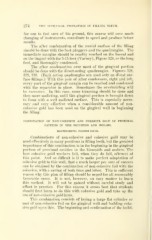Page 574 - My FlipBook
P. 574
274 THE TECHNICAL PROCEDURES IN FILLING TEETH.
for one to feel sure of his ground, this course will save much
changing of instruments, contribute to speed and produce better
results.
The after condensation of the mesial surface of the tilling
should be done with the foot pluggers and the quadrangles. The
immediate margins should be readily reached on the buccal and
on the lingual with the 5-15 foot (Varney), Figure 324, or the long
foot, and thoroughly condensed.
The after condensation over most of the gingival portion
should be done with the direct-acting quadrangles. Figures 328,
329, 330. (Back action quadrangles are used only on distal sur-
face fillings.) With this pair of after condensers, right and left,
every part of the gingival margin can be reached and condensed
with the separator in place. Sometimes the overbuilding will
be excessive. In this case, some trimming should be done and
then more malleting, until this gingival portion is brought down
to form with a well malleted surface. This is especially neces-
sary and very effective when a considerable amount of non-
cohesive gold has been used on the gingival wall in beginning
the filling.
COMBINATION OF NON-COHESIVE AND COHESIVE GOLD IN PROXIMAL
CAVITIES IN THE BICUSPIDS AND MOLARS.
ILLUSTRATIONS: FIGURES 356-364.
Combinations of non-cohesive and cohesive gold may be
used effectively in many positions in filling teeth, but the greatest
importance of this combination is in the beginning in the gingival
portion of proximal cavities in the bicuspids and molars. The
best cohesive gold workers fail, when they do fail, oftenest at
this point. And so difficult is it to make perfect adaptation of
cohesive gold to this wall, that a much larger per cent of success
can be obtained by the combination of non-cohesive foil with the
cohesive, with a saving of both time and labor. This is sufficient
reason why this plan of filling should be urged for all reasonably
favorable cases. It is not, however, an easy matter to learn
this method. It will not be gained without careful study and
effort in practice. For this reason it seems best that students
should first learn to do this with cohesive gold and take up the
use of non-cohesive gold later.
This combination consists of laying a large flat cylinder or
mat of non-cohesive foil on the gingival wall and building cohe-
sive gold upon this. The beginning and continuation of the l)uild-


